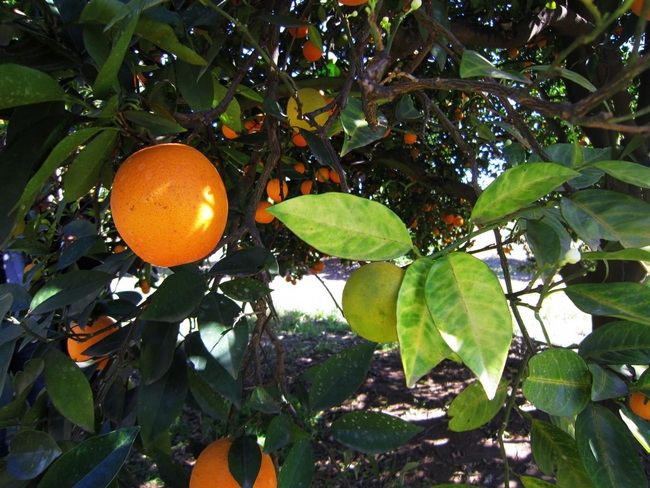LAKE ALFRED, Fla. — Sometimes in science, a new perspective brings an “a ha!” moment. That's what one senior researcher at the University of Florida Institute of Food and Agricultural Sciences believes happened with his latest research on Huanglongbing (HLB), or citrus greening.
HLB is worldwide, devastating citrus disease caused by Candidatus Liberibacter asiaticus (CLas), a bacterium that settles into the tree's phloem — its interior vascular system — eventually killing the tree. Since first found in Florida in 2005, it has infected virtually every grove in Florida and cost the citrus industry billions of dollars.
UF/IFAS' Nian Wang's most recent research describes in detail how HLB causes damage to citrus trees and presents the case that HLB is a pathogen-triggered immune disease. A pathogen-triggered immune disease is a disease that results from the activation of an organism's immune cells fighting a pathogen (a virus, bacteria, or parasite) that invades an organism, in this case, the citrus plant.
This is the first time that this explanation of HLB symptoms as pathogen-triggered immune responses has been presented and defended. Seeing HLB in this new context may mean finding new solutions to the disease, faster. Pathogen-triggered immune diseases have not been reported in the world of plants that includes over 250,000 species but are common in humans.
Scientists don't fully understand how the pathogen that causes HLB damages infected citrus plants because it has not been cultured in artificial media. With this new evidence that supports a premise that HLB is an immune-mediated disease, researchers can see new light on how to manage HLB.
Through his research Wang, has shown HLB infection stimulates systemic and chronic immune responses in phloem tissue, especially overproduction of reactive oxygen species (ROS), which are part of the plant's immune response. Chronic and excessive ROS production is responsible for systemic cell death of phloem tissues, which in turn causes HLB symptoms. This supports the hypothesis that HLB is an immune-mediated disease.
Antioxidants and immunoregulators are commonly used to treat human immune-mediated diseases. They halt or reduce the process that results in cell death. In citrus, the researchers tested whether growth hormones like gibberellin acid (GA) and antioxidants (uric acid and rutin) could impact cell death triggered by the infection and, therefore, block or reduce HLB symptoms.
The researchers found the GA and uric acid had an encouraging positive impact on infected trees. This has also been supported by other research in process at the UF/IFAS Citrus Research and Education Center.
“Our findings allow us to control HLB by mitigating ROS with integrated horticultural measures, genetic improvements of citrus varieties with antioxidant enzymes, generating non-transgenic HLB resistant/tolerant citrus varieties by editing key genes required for CLas-triggered ROS production, and using CTV-mediated expression of antioxidant enzymes and silencing of key genes required for CLas-triggered ROS production,” said Wang, a professor of microbiology and cell science at UF/IFAS.
Wang's research also tested existing grove management practices that integrate antioxidants, micronutrients (activating antioxidant enzymes), gibberellin (mitigating ROS, regulating immune response, and promoting new growth) and optimized fertilization and irrigation (reducing ROS production) that are available in Florida. All the products tested, except the antioxidants, have already been registered for citrus production, thus can be easily adopted by citrus growers.
Wang's research has also identified the RBOHD gene to be the main producer of CLas-triggered ROS. With this, the researchers can now “edit (using CRISPR technology)” or “silence” RBOHD or specific receptor gene(s) responsible for RBOHD activation and the resulting cell death of phloem tissues and HLB symptom development. It is expected these approaches will allow economic and efficient citrus production in HLB endemic citrus production regions such as Florida and Texas and provide the long-term solution against HLB for all citrus production regions of U.S. (including California) in case that HLB becomes endemic in the future.
Read the whole story:
Key Points About Plant "Immunity"
-
Unlike vertebrates, plants do not have an adaptive immune system. Nonetheless, plants can launch specific, self-tolerant immune responses and establish immune memory.
-
To promote virulence, pathogens inject effector molecules that target conserved immune signalling hubs into the plant cell. In response, plants have evolved resistance (R) proteins that detect effector-induced perturbations in these hubs, providing the potential to specifically recognize a large number of pathogens with similar infection strategies through a smaller number of R proteins.
-
Intraspecific and interspecific plant crosses suggest that autoimmunity can arise from self-reacting R proteins, illustrating the threat of uncontrolled R protein activity. Dynamic transcriptional and post-transcriptional regulation of R protein levels is thought to minimize the risk of autoimmunity in plants.
-
Pathogen-infected tissues generate a mobile immune signal consisting of multiple proteins as well as lipid-derived and hormone-like molecules. These signal molecules are transported to systemic tissues, where they induce systemic acquired resistance (SAR). SAR is associated with the systemic reprogramming of thousands of genes to prioritize immune responses over routine cellular requirements.
